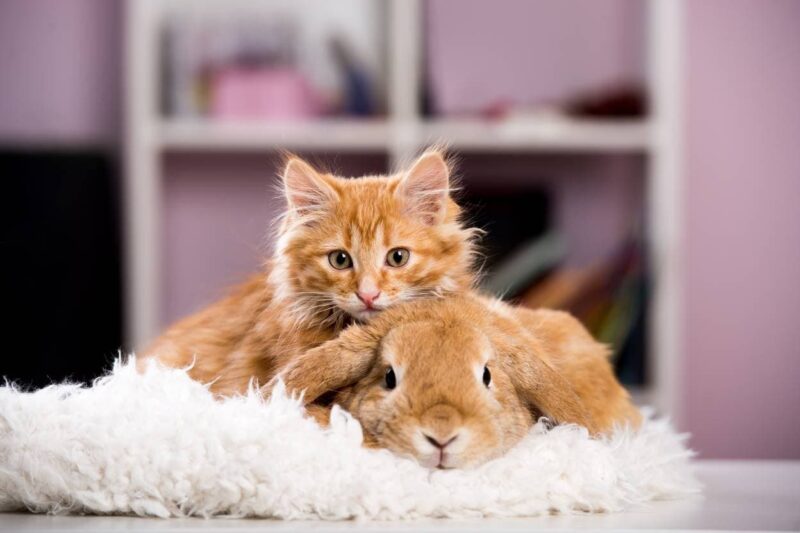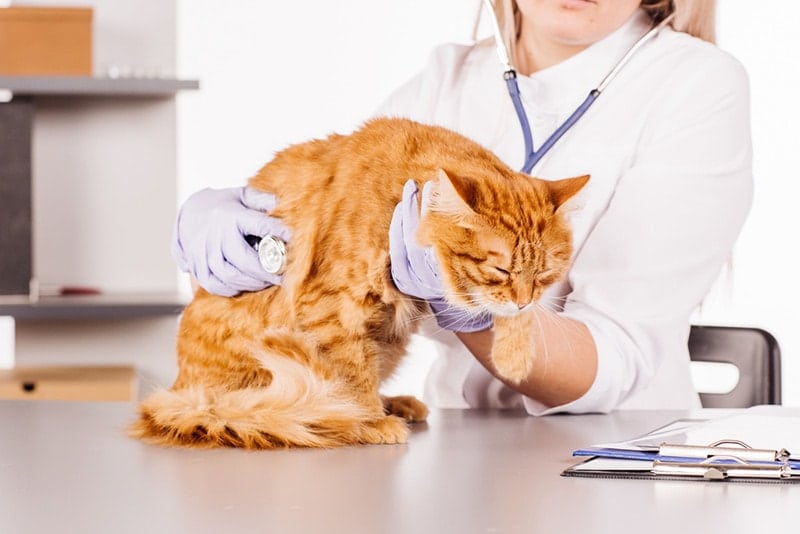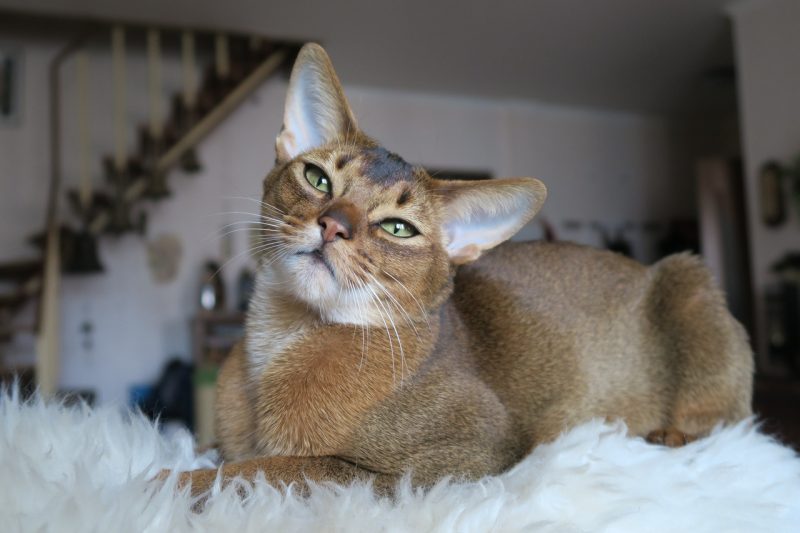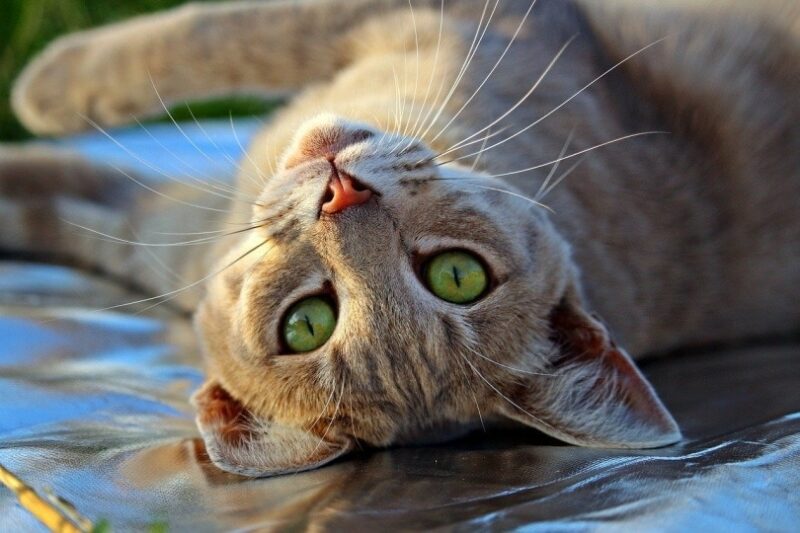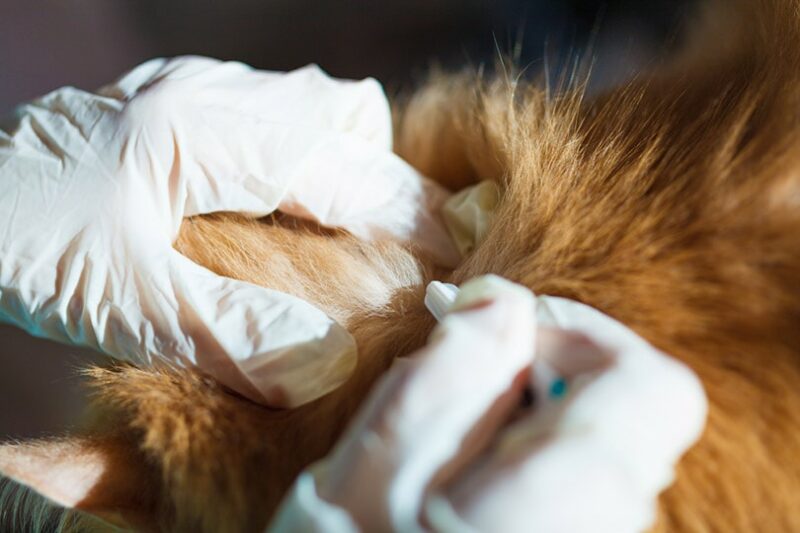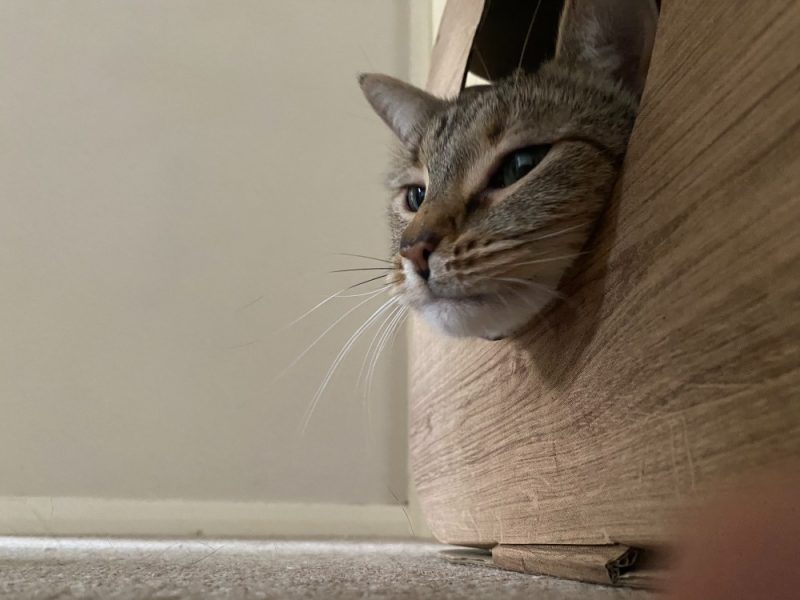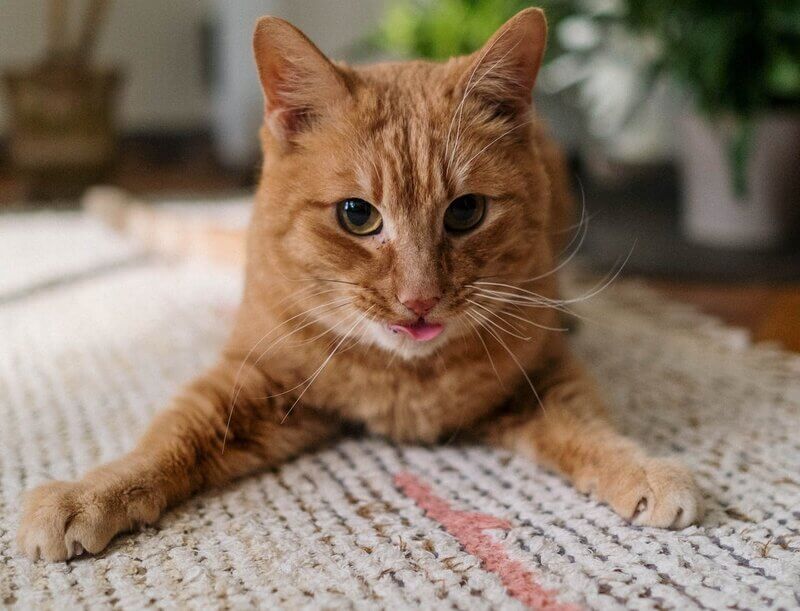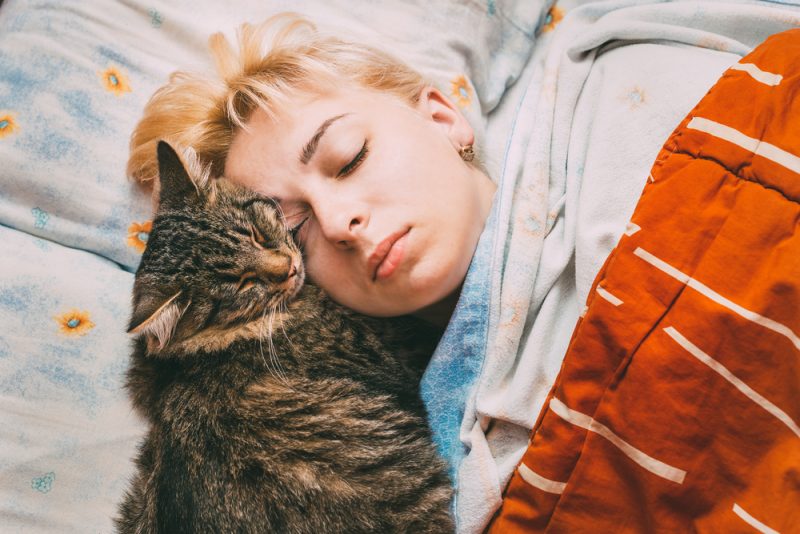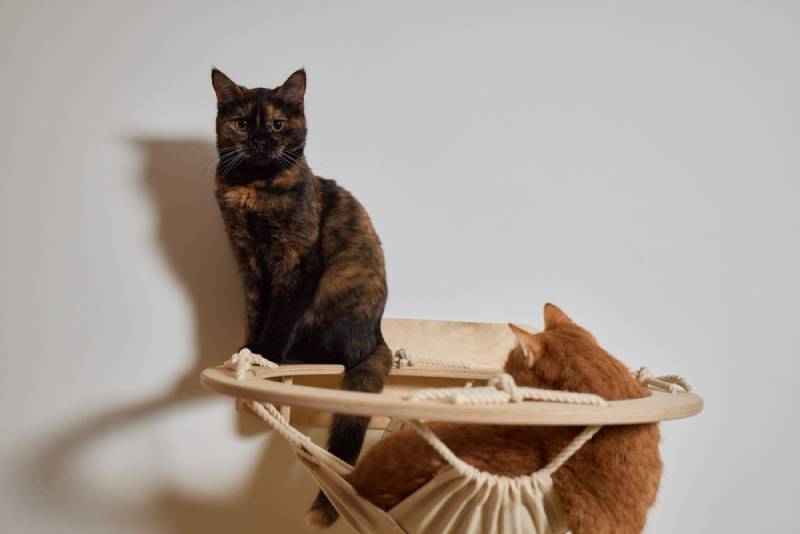Let’s cut to the bunny chase. Rabbits and cats can live in the same household if all the necessary precautions have been met, but these two species coexist in the wild as a complex predator-prey relationship. This means that it will never be entirely safe letting these two animals interact directly with each other, no matter how well they have been trained or how long they have lived in the same house.
The safest way to keep both animals is to ensure their own private and secure space, where they cannot be approached by the other pet and do not interact with each other, even with supervision. That is not to say that there aren’t rabbits and cats that live more closely together as friends, but this is quite rare and not worth the risk.
Cats have a hunting instinct toward rabbits, which is stronger in some individuals than others, and the only potential way to try and introduce the two species gradually is with a young kitten and an assertive rabbit, although this is not without risks either. You would have to artfully introduce the two animals very slowly. Even that does not guarantee they will get along and that the cat would not attempt to attack the rabbit when they grow up.
Please be mindful if you are considering introducing your kitten to a rabbit, that the two animals may still injure each other at any stage throughout their life, sometimes fatally, despite their previous tolerable coexistence. This should only be attempted with extensive knowledge and experience in keeping these two pet species, with certain requirements in mind, such as never introducing an adult cat directly to a rabbit but only a young kitten, and by seeking the help of a veterinary professional or an animal behaviorist in the process.
Our article provides some safety tips on how this could be attempted, but it does not guarantee success, and the risk of the animals injuring each other will always be present. Cats and rabbits can and will happily live in the same household without ever crossing paths, and this is the only safe way to ensure both pets’ welfare needs and security requirements are met.
Before the Controlled Introduction
The truth is that rabbits are prey and cats are hunters. Both animals will exhibit predator and prey behavior when they see each other, particularly for the first time or during the initial months, but also even if they have lived in the same house for years. This is a built-in mechanism, and their behavior can never be fully predicted. A rabbit hopping around may be enough to provoke a cat and wake their hunting instincts.
How well these two pets may tolerate each other’s existence will also greatly depend on the individual animal’s personality. A kitten will be more timid and cautious than an adult cat, while an assertive or territorial rabbit may not be as fearful. These types of personalities and age groups may be the only combination that could be attempted for an actual introduction, but knowing there will still be risks for both pets.
Before you begin, it goes without saying that you need to have a trusting relationship with your rabbit and kitten first, then you can focus on trying to introduce the two pets. Your rabbit should be accustomed to being handled and being around you. Timid rabbits who dislike handling or those who are reactive and easily scared by strange noises and new environments, often running back to their hutch to hide, are not the type of personality you want to introduce to a kitten. These rabbits are easily scared and will get stressed seeing a predator animal, be it a kitten or not.
However, if your kitten is young and calm and your bunny is curious, confident, and assertive, then you may proceed cautiously with the following steps, keeping in mind all the risks we discussed.

The 5 Steps to Introducing a Kitten to a Rabbit
1. Start With Scent Exchange
Animals communicate through scent, so a scent exchange always starts things off on the right foot. A scent exchange means offering your kitten something covered in the rabbit’s scent and vice versa. It’s as if two people talked behind closed doors. Your rabbit can’t see your kitten, and your kitten can’t see your rabbit, but the two are getting to know each other on their terms.
You can offer anything as long as it’s safe, like a favorite toy or a blanket. Another option is rubbing a piece of cloth on your rabbit’s back, then leaving the fabric for your kitten to inspect. You could do the same thing with your kitten. Observe each animal’s reaction, particularly the rabbit. Leave the cloth or other object with the scent outside of their hutch first, and let the rabbit explore it as they wish.
If the rabbit is avoiding it or becomes fearful, they may take longer to get used to the scent of a predator animal. Many may never accept it and should not be forced into any further attempts of introductions. Rabbits that show interest in the scent object and then continue with their own business, as if the object is not even there, can continue with the slow introductions. You can place the object closer to their hutch gradually and continue observing their reactions. Familiarize yourself with your pets’ body language, so you can easily recognize signs of stress and unease.
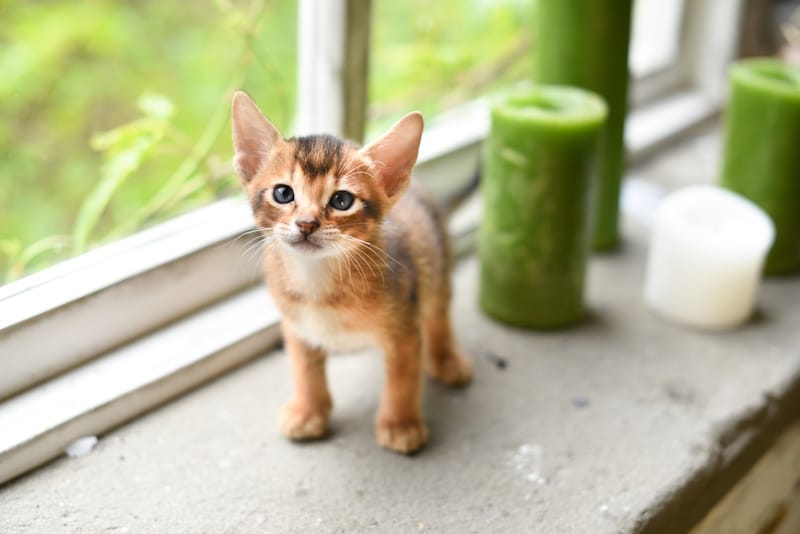
2. Find a Calm and Secure Space
The space you choose dramatically impacts the success of the meet-n-greet. Ensure there is plenty of open space and lighting. When it’s time for face-to-face introductions, choose an area free from noise and foot traffic.
Rabbits are territorial and can become aggressive if a kitten enters their domain, so choose a space that neither your kitten nor rabbit visits often, but where the rabbit feels comfortable and confident in.
3. Secure One of the Animals in an Enclosure or a Carrier
The first meet and greet should be for visual introduction only. You never know what could happen, so it’s best to err on the side of caution and either keep your rabbit in an enclosure or keep the kitten in a carrier box or a crate.
The rabbit’s enclosure can be a hutch or a large crate where the rabbit has their own privacy and safety, a place to hide out of sight but where they can still see the kitten. Do not allow the kitten to get too close to the hutch for the first few introductions, and it would be better to allow the rabbit to make the first step when they are ready.
Next, allow the rabbit to hop out of their hutch if they choose so by leaving it open, while the kitten is in a closed crate or a carrier. Provide a safe hiding nook for your rabbit if they want to hop back to safety. Let the rabbit explore the room and get close to the cat carrier if they wish to. If there is any sign of fear or stress on either side, stop the interaction.
Allow this kind of indirect interaction to continue for a few minutes a day, slowly prolonging it if both animals are coping well. You may repeat it daily.
Suppose there isn’t any flight reaction from the rabbit or stalk behavior from the cat. In that case, you can allow either animal, depending who is loose in the room and who is in a crate, to slowly get closer to the other pet. A rabbit may thump or try to charge toward the cat’s box as a sign of dominance, and this may certainly scare the kitten but also show them to fear the rabbit rather than consider them prey.
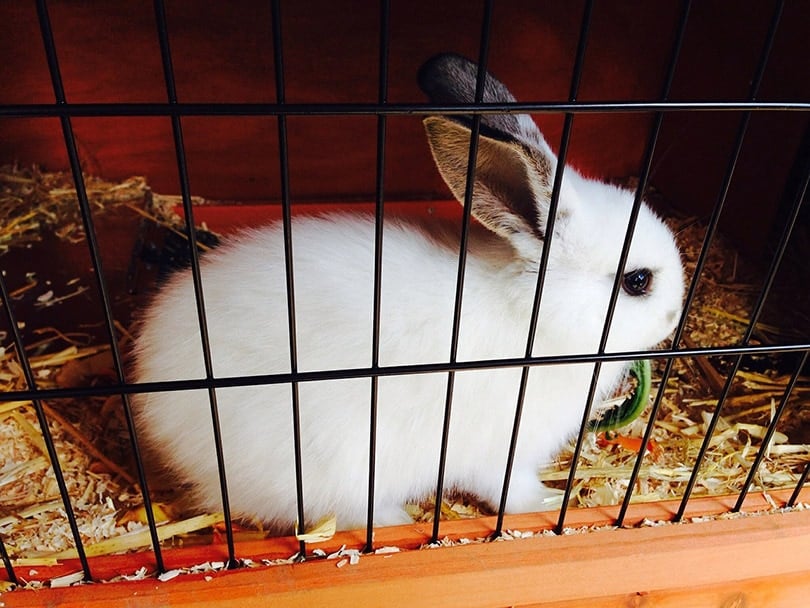
4. Offer Treats During the Introduction
You should offer treats to your kitten and rabbit to keep the introduction fun and stress-free. The treat should be something delicious and enticing that your kitten doesn’t usually eat. Likewise, offer your rabbits some treats like fresh grass or dandelions.
5. Watch for Signs of Stress
Observing signs of stress is the most important part of first introductions with any animal. You’ll improve the more you get to know your rabbit, but some common signs of stress and even aggression may include:
- Flattened ears against the body
- Tense, crouched position
- No nose twitching
- Running away
- Thumping
- Grunting
- Sitting upright and digging with the front paws
- Showing their front teeth
Your rabbit is very likely to show at least one of these signs during the first few introductions. Over time, these signs may diminish if the two animals are getting more accustomed to being comfortable in each other’s presence. If, however, they aren’t or are getting even more stressed, then this should be acknowledged and respected, and each animal should live in their secure environment without seeing each other again.

Is One Introduction Enough?
Here’s where people run into potentially life-threatening trouble for the rabbit. They desperately want their cat and rabbit to become best friends and end up rushing the introduction, or they only do one meet-and-greet. With predator-prey relationships, you must plan for multiple meetings in the beginning, and this may take months, while some animals will never get accustomed to each other, and that’s fine. Don’t force it. Introducing a cat and a rabbit should only ever be attempted if you have a young kitten and you are aware of all the risks associated with this unnecessary interaction.
The majority of cats and rabbits will never be friends, and the risk of your cat injuring or even killing the rabbit will always be there. Animal safety and welfare should always be our top priority. Animal relationships take time to develop, and predator-prey friendships are extremely rare. More commonly, attempts to introduce these two species end up in injuries for one or both animals, or worse.
Cats have to learn to overcome their hunting instincts, and rabbits have to learn to stay calm in the presence of a hunter. That’s not easy and may be almost impossible for the majority of these animals. Consult with a vet or an animal behaviorist, and consider these risks and precautions if you want to introduce your kitten to a rabbit.
If you need to speak with a vet but can't get to one, head over to PangoVet. It's an online service where you can talk to a vet online and get the advice you need for your pet — all at an affordable price!

Conclusion
Can rabbits and cats be best friends? Rarely, and this should not be pursued or forced! These two species have a classical predator-prey relationship, and the safety of their interaction can never be guaranteed when it comes mainly to the health and welfare of the rabbit, no matter how long these pets lived in the same household.
Speak to a vet and consider the precautions and risks we discussed in this article when considering introducing a kitten to a rabbit.
Featured Image Credit: Sharomka, Shutterstock
